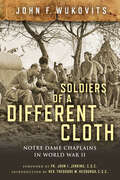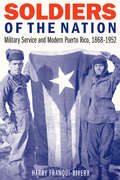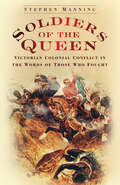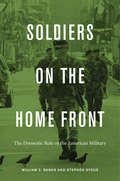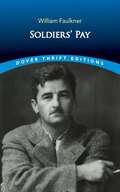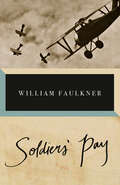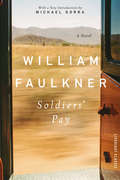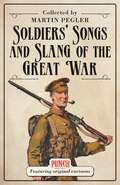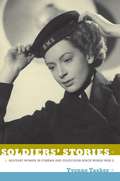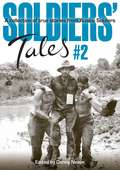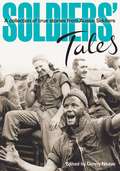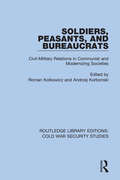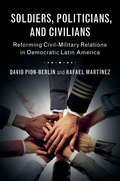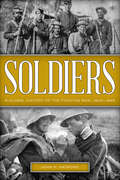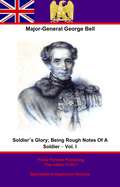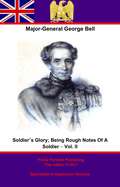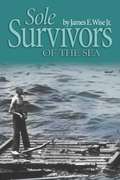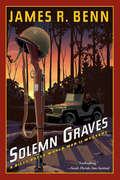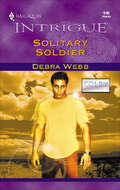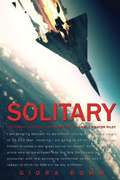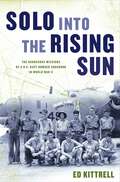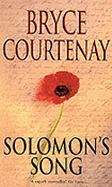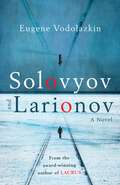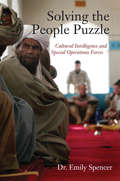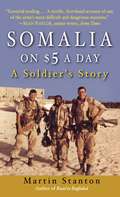- Table View
- List View
Soldiers of a Different Cloth: Notre Dame Chaplains in World War II
by John F. Wukovits&“This riveting account of the heroic contributions of thirty-five chaplains and missionaries during World War II is nearly impossible to put down . . . inspiring.&” —The Boston Pilot In Soldiers of a Different Cloth, New York Times-bestselling author and military historian John Wukovits tells the inspiring story of thirty-five chaplains and missionaries who, while garnering little acclaim, performed extraordinary feats of courage and persistence during World War II. Ranging in age from twenty-two to fifty-three, these University of Notre Dame priests and nuns were counselor, friend, parent, and older sibling to the young soldiers they served. These chaplains experienced the horrors of the Death March in the Philippines and the filthy holds of the infamous Hell Ships. They dangled from a parachute while descending toward German fire at Normandy and shivered in Belgium&’s frigid snows during the Battle of the Bulge. They languished in German and Japanese prison camps, and stood speechless at Dachau. Based on a vast collection of letters, papers, records, and photographs in the archives of the University of Notre Dame, as well as other contemporary sources, Wukovits brings to life these nearly forgotten heroes who served wherever duty sent them and wherever the war dictated. Wukovits intertwines their stories on the battlefronts with their memories of Notre Dame. In their letters to their superior in South Bend, Indiana, they often asked about campus, the Grotto, and the football team. Soldiers of a Different Cloth will fascinate and engage all readers interested in the history of World War II and alumni, friends, and fans of the Fighting Irish.
Soldiers of the Nation: Military Service and Modern Puerto Rico, 1868-1952 (Studies in War, Society, and the Military)
by Harry Franqui-RiveraAs the island of Puerto Rico transitioned from Spanish to U.S. imperial rule, the military and political mobilization of popular sectors of its society played important roles in the evolution of its national identities and subsequent political choices. While scholars of American imperialism have examined the political, economic, and cultural aspects of U.S. colonialism in Puerto Rico, few have considered the integral role of Puerto Rican men in colonial military service and in helping to consolidate the empire. In Soldiers of the Nation Harry Franqui-Rivera argues that the emergence of strong and complicated Puerto Rican national identities is deeply rooted in the long history of colonial military organizations on the island. Franqui-Rivera examines the patterns of inclusion-exclusion within the military and the various forms of citizenship that are subsequently transformed into socioeconomic and political enfranchisement. Analyzing the armed forces as an agent of cultural homogenization, Franqui-Rivera further explains the formation and evolution of Puerto Rican national identities that eventually led to the creation of the Estado Libre Asociado (the commonwealth) in 1952. Franqui-Rivera concludes that Puerto Rican soldiers were neither cannon fodder for the metropolis nor the pawns of the criollo political elites. Rather, they were men with complex identities who demonstrated a liberal, popular, and broad definition of Puertorriqueñidad.
Soldiers of the Queen: Victorian Colonial Conflict in the Words of Those Who Fought
by Stephen ManningIt may come as some surprise that in such a popular area of military history there is no book that focuses on the experience of the Victorian soldier - from recruitment to embarkation, fighting and perhaps returning, perhaps dying - in his own words. Dr Manning's meticulous research in primary sources gives the lie to the received image of the disciplined, redcoated campaigner of Victorian art and literature: for one thing, by the time he arrived at his destination, the coat would have been in rags. The distances covered on march were unbelievable, through desert and disease-ravaged swamp. Lavishly illustrated throughout, all the major Colonial campaigns and most of the minor ones are featured. To understand how what was in reality a tiny standing army controlled the largest empire the world has ever seen, this book is a must.
Soldiers on the Home Front: The Domestic Role of the American Military
by William C. BanksWhen crisis requires U.S troops to deploy on American soil, the nation depends on a rich body of law to establish lines of authority, guard civil liberties, and protect democratic institutions. William Banks and Stephen Dycus analyze the military's domestic role as it is shaped by law, and ask what we must learn and do before the next crisis.
Soldiers' Pay (Dover Thrift Editions: Classic Novels)
by William FaulknerWilliam Faulkner is one of the most important American writers of the twentieth century, yet success was elusive when he published his first novel, Soldiers’ Pay, in 1926. Capturing the post–World War I atmosphere of the Lost Generation on American soil, Faulkner explores the war’s emotional impact on three weary veterans and their Southern hometown in Georgia. Experimental narrative techniques blended with literary modernism set the foundation for Faulkner to receive the Nobel Prize in Literature and two Pulitzer Prizes.
Soldiers' Pay (Vintage International)
by William FaulknerWilliam Faulkner's first novel is one of the most compelling works of American fiction to emerge from the First World War.A wounded veteran's homecoming is at the center of Faulkner's first novel. Badly scarred in body and mind, and unable to remember much, Donald Mahon is brought home at the end of the World War I by a fellow soldier and a young war widow they befriend on the train. Mahon's arrival is a shock to his hometown, however, for he had long since been reported dead. His flighty young fiancee is caught between her revulsion at his condition and her sense of duty, while Mahon's father greets his unexpected survival first with joy and then with a determined denial of what his grievous injuries mean. As events unfold, alliances are formed and broken, sacrifices are made, and Faulkner deftly invests his heartbreaking tale with some of the deeper themes that would come to mark his later masterpieces.
Soldiers' Pay: Carbon Typescript (Picador Classics Ser.)
by William Faulkner“A deft hand has woven this narrative. . . . This book rings true.”—New York Times Faulkner’s debut novel, Soldiers’ Pay (1926), is among the most memorable works to emerge from the First World War. Through the story of a wounded veteran’s homecoming, it examines the impact of soldiers’ return from war on the people—particularly the women—who were left behind.
Soldiers' Songs and Slang of the Great War
by Martin PeglerHave you ever "gotten dirty at the crossroads" in a "knocking shop"? Or been in a "bun-fight"? Can you sing "I Wonder Who's Kissing Her Now?", "Bicycle Built for Two" or "Danny Boy"? Soldiers' Songs and Slang of the Great War explains the meaning and origins of the language and songs of WW1.A bawdy and satiric celebration of cheerful determination in the face of appalling adversity, this book brings forth the sense of humor of the American, Canadian, Australian, and British soldier in the trenches of World War I. Published to coincide with the centenary of the First World War, this collection of rousing marching songs, cheering ditties, evocative sing-alongs, and complete diction of soldiers' slang reveals the best of Allied humor of the period. Wonderfully illustrated with Punch cartoons, posters, and the soldiers' own Wipers' Times, this nostalgic book will not only delight but also give a real sense of daily life amidst the mud and blood of the trenches.
Soldiers' Stories: Military Women in Cinema and Television Since World War II
by Yvonne TaskerFrom Skirts Ahoy! to M*A*S*H, Private Benjamin, G. I. Jane, and JAG, films and television shows have grappled with the notion that military women are contradictory figures, unable to be both effective soldiers and appropriately feminine. In Soldiers' Stories, Yvonne Tasker traces this perceived paradox across genres including musicals, screwball comedies, and action thrillers. She explains how, during the Second World War, women were portrayed as auxiliaries, temporary necessities of "total war. " Later, nursing, with its connotations of feminine care, offered a solution to the "gender problem. " From the 1940s through the 1970s, musicals, romances, and comedies exploited the humorous potential of the gender role reversal that the military woman was taken to represent. Since the 1970s, female soldiers have appeared most often in thrillers and legal and crime dramas, cast as isolated figures, sometimes victimized and sometimes heroic. Soldiers' Stories is a comprehensive analysis of representations of military women in film and TV since the 1940s. Throughout, Tasker relates female soldiers' provocative presence to contemporaneous political and cultural debates and to the ways that women's labor and bodies are understood and valued.
Soldiers' Tales #2: A Collection of True Stories from Aussie Soldiers
by Denny NeaveSoldiers' Tales #2 is a unique collection of personal accounts told by soldiers or relatives who have lived with their stories. Spanning the period from World War I through to the conflicts of the modern era, these stories are a mixture of the humorous and the intensely emotional. This collection is unmistakably Australian and is a combination of larrikin yarns and other more serious stories that tell of tragedy and often unspoken pain.
Soldiers' Tales: A Collection of True Stories from Aussie Soldiers (Big Sky Publishing Ser.)
by Denny NeaveIn their own words the Aussie diggers provide a fascinating glimpse of the many funny and touching moments that our Diggers often hold to their chest. The collection of stories in this book provides a taste of what a soldier's life is like both in war and peace.
Soldiers, Peasants, and Bureaucrats: Civil-Military Relations in Communist and Modernizing Societies (Routledge Library Editions: Cold War Security Studies #46)
by Roman Kolkowicz; Andrzej KorbonskiThis book, first published in 1981, is a comprehensive examination of the main theoretical, methodological and empirical approaches to the study of the military in modernising political systems, in socialist and non-socialist countries. It analyses civil-military relations in the Middle East, Eastern Europe and China, and in doing so sheds new light on the comparative politics and strategic affairs of the Cold War period.
Soldiers, Politicians, and Civilians: Reforming Civil-Military Relations in Democratic Latin America
by David Pion-Berlin Rafael MartínezAre interactions between soldiers, politicians, and civilians improving? Every nation has to come to grips with achieving a more enduring harmony between government, the armed forces, and society if it aspires to strengthen its democracy. While there is an abundance of studies on civil-military affairs, few examine all three of these actors, let alone establish any standards with which to assess whether progress is being made. This ambitious book devises a novel framework equipped with six dimensions, each of which opens a unique window into civil-military affairs, and which form a more integrated view of the subject. Those dimensions are accompanied by a set of benchmarks and metrics that assess progress and compare one country against another. The framework is applied to case studies of Argentina, Brazil, Chile, and Uruguay, with the conviction that insights could be gleaned that may be relevant elsewhere. Ultimately, by unpacking the civil-military relation into its various dimensions, this study has shed light on what it takes to transform what was once a politically-minded military into an organization dedicated to serving a democratic state and society.
Soldiers: A Global History of the Fighting Man, 1800–1945
by John A HaymondA global study of how soldiers lived, worked, and fought, and how many died, spanning from the Napoleonic War to World War II. No matter the war, no matter the army, no matter the nationality, common threads run through the experiences of men at war. Soldiers highlights these shared experiences across 150 years of warfare, from the Napoleonic Wars through World War II and everything in between, such as the Mexican and Crimean Wars, the American Civil War, the U.S. Indian Wars and Britain&’s imperial bush wars, the Boxer Rebellion, the Boer War, the First World War, and more. Haymond explores the experiences that connect soldiers across time and space and draws heavily from firsthand accounts to craft a narrative with flesh-and-blood immediacy. Soldiers is entertaining and informative: history at its best. Praise for Soldiers&“What makes Soldiers an interesting read is Haymond&’s writing style and technique of comparing the common experiences of fighting men regardless of uniform and time served during the period.... Highly recommended for both scholars and students alike. It is a must for readers interested in the experience and psychology of being a warrior during this period.&”—Military Review: The Professional Journal of the United States Army
Soldier’s Glory; Being “Rough Notes Of A Soldier” – Vol. I (Soldier’s Glory; Being “Rough Notes Of A Soldier” #1)
by Major-General George Bell C. B.This ebook is purpose built and is proof-read and re-type set from the original to provide an outstanding experience of reflowing text for an ebook reader. George Bell was a young Irishman of only seventeen when he undertook his first campaign in the British Army. Recruits were sorely needed to fill the ranks after the sanguinary battle of Albuera in 1811. He joined his regiment, the 34th or Cumberland Gentlemen, forthwith and so his military career started in some of the hardest fighting of the Peninsular War. In the thick of it at the siege of Badajoz, Arroyo Molinos, and Vittoria, he was part of General Rowland Hill's division as the British troops battled northward toward the French frontier. He was heavily engaged in the battles of the Pyrenees, the Nive, the Nivelle, Bayonne and Toulouse. Of each he leaves a good sketch of the action that he and his comrades took part in, but is careful only to record what he saw. Between the deadly engagements with the French, or "Johnny Crappo", as Bell and his men know him, Bell leaves a rich account of the daily life of a young subaltern in the war: often ill-provided for, hungry, and frequently unable to find shelter, prey to petty thieves. Additionally, the misadventures of his men (or more often their wives, who accompanied the march) provided for much amusement and not a little trouble! After the successful conclusion of the Peninsular campaign, George returns to his native Ireland for a brief period of half-pay, champing at the bit to get back on full pay, and then sets off with his newly wed wife to India. His descriptions of the colonial life are vivid and varied, as he dodges sun-stroke, ill-intentioned servants, fever, disease and cobras. He travels far and wide leaving accounts of Seringaptam, Madras, Bangalore, Bombay, Burma, and Rangoon in particular. The local populace and their cultures are described in some detail, along with the buildings, religious practices, the political figures and royal families. Bell's books brim with interesting and witty asides and anecdotes, and it is clear that he took to the lighter side of life during his many travels. He is not a stuffed shirt of the old breed, and avoids much of the Victorian coldness in his writing, although supremely confident of his superiority in religious contexts. An animated and vibrant read. Text taken, whole and complete from the 1867 edition, Day and Son Ltd, London. Original -366 pages Author - Major-General George Bell - (1794 - 1877) Illustrations - 1 Portrait Linked TOC.
Soldier’s Glory; Being “Rough Notes Of A Soldier” – Vol. II (Soldier’s Glory; Being “Rough Notes Of A Soldier” #2)
by Major-General George Bell C. B.This ebook is purpose built and is proof-read and re-type set from the original to provide an outstanding experience of reflowing text for an ebook reader. Volume Two of General Bell's memoirs begins with his journey back to Britain from India, stopping on the way at St. Helena to pay his respects at the tomb of Napoleon. He is then posted to Canada, taking part in putting down a rebellion led by republican Canadians, and his further travels lead him back to Europe via the United States. His reminiscences form a travelogue with a military slant, capturing the environs and habits of the populations with a delicate piquancy. Frustrated by court intrigue and influence stunting his further advancement in the service, in peacetime circumstances he would have been stuck with dismal prospects for the future. Many years after his baptism of fire in the Napoleonic Wars, he is posted as part of the British expeditionary force under Lord Raglan to the Crimea. Despite horrific conditions, he leads his men in the battles of Alma and Inkerman. His commentary of the daily life in the trenches recalls the slough of despond of the First World War: the mud, blood, shelling and disease are recalled along with the scarcity of supplies. Infuriated by the blundering politicians, Bell writes a passionate letter to the Times, which (although truthful) does nothing to help his advancement. By a stroke of luck he is plucked from his pestilent surroundings by a staff posting offered by an old comrade. As he recovers his health, he travels once more to Canada and to the United States, just at the turn of the Civil War, meeting such luminaries as General McClellan and General Scott. He briefly meets with the great Lincoln who he describes as "thin and wiry...very kind and familiar in his manner to all, but a very commonplace-looking man". As with his first volume, Bell maintains his narrative with wit and verve, not without a few passing shots at his particular gripes, the Army hierarchy and Roman Catholicism. Text taken, whole and complete from the 1867 edition, Day and Son Ltd, London. Original -382 pages Author - Major-General George Bell C.B. - (1794 - 1877) Linked TOC.
Sole Survivors of the Sea
by James E. Wise JrThe incredible stories of twenty-two lone survivors of maritime disasters are presented in this collection of war and peacetime incidents. The dramatic accounts--including those of a British sailor who survived 133 days at sea on an open raft and a German sailor who spent 28 hours in the ocean without a life preserver--are based on a wide array of sources, including interviews with the survivors and their families and official records to back up their accuracy. Most took place in World War II, when the navies and merchant fleets of many nations roamed the seas. Each story is one of boundless courage, a tenacious will to survive, and, in many cases, good luck.
Solemn Graves (A Billy Boyle WWII Mystery #13)
by James R. BennUS Army detective Billy Boyle is called to investigate a mysterious murder in a Normandy farmhouse that threatens Allied operations. July, 1944, a full month after D-Day. Billy, Kaz, and Big Mike are assigned to investigate a murder close to the front lines in Normandy. An American officer has been found dead in a manor house serving as an advance headquarters outside the town of Trévières. Major Jerome was far from his own unit, arrived unexpectedly, and was murdered in the dark of night. The investigation is shrouded in secrecy, due to the highly confidential nature of the American unit headquartered nearby in the Norman hedgerow country: the 23rd Headquarters Special Troops, aka, the Ghost Army. This vague name covers a thousand-man unit with a unique mission within the US Army: to impersonate other US Army units by creating deceptions using radio traffic, dummy inflatable vehicles, and sound effects, causing the enemy to think they are facing large formations. Not even the units adjacent to their positions know what they are doing. But there are German spies and informants everywhere, and Billy must tread carefully, unmasking the murder while safeguarding the secret of the Ghost Army—a secret which, if discovered, could turn the tide of war decisively against the Allies.
Solitary Soldier (Colby Agency #4)
by Debra WebbTHERE IS ONLY ONE MAN WHO CAN HELP YOU. IF HE'LL TAKE YOUR CASE."--Victoria Colby of the Colby Agency to Rachel Larson, desperate motherShe'd heard his heart was as hard as his honed body and as cold as the steel of his gun. But the man called Sloan was Rachel Larson's last hope. She had nowhere left to hide from her son's father--a cold-blooded assassin, and Sloan's deadliest enemy. So she would face this lone wolf in his lair and plead for his help... .Ex-agent Sloan lived only to take down the man who'd killed all he loved. Now a desperate, desirable woman offered him that chance on a silver platter. Vengeance was his--if he could keep Rachel and her son from invading the fortress around his heart....
Solitary: The Crash, Captivity and Comeback of an Ace Fighter Pilot
by Giora Romm"Fighter pilots tell the greatest stories and the great ones tell the best stories of all. . . " --PAT CONROY, bestselling author of The Great Santini Giora Romm was the Israeli Air Force's first fighter ace. As a twenty-two-year-old lieutenant he shot down five MiGs during the Six Day War of 1967. Fourteen months later over the Nile Delta, an Egyptian missile exploded beneath the tail of his Mirage IIIC. Within moments Romm found himself hanging by the straps of his parachute, with a broken arm and a leg shattered in a dozen places, looking down from 10,000 feet. Streams of farmers and field workers converged below onto the spot toward which his chute was descending, with the intention, he was certain, of hacking him to death as soon as his feet touched the earth. No other Israeli pilot had survived capture in Egypt or in any other Arab state. Solitary is Romm's story of his imprisonment, torture, interrogation, release, and return to service. Solitary is not a "war book. " It's not a tale of heroism, though if anyone ever qualified for that distinction, it is this story's author. Solitary is not even, in its deepest parts, about captivity or imprisonment. Solitary is about Romm's inner war. It's the story, in his phrase, "of a fall from a great height," not only literally but metaphorically. Romm could not tell his captors the truth about who he was or what he had done. He had to invent an entire fictional biography and keep it straight in his head through months of beatings and interrogations, all the while being held in solitary confinement with his body sheathed from chest to toe in a plaster cast. Solitary is not a grim book. It's full of wry humor, keen self-observations and revelations. An ordeal such as Romm endured is a sojourn in hell, but it is also a passage. Romm fell, and he came back. Solitary is his indelible account of confronting his own fears and limitations, and discovering, ultimately, his capacity to survive and to prevail. --From the Introduction by Steven Pressfield
Solo into the Rising Sun: The Dangerous Missions of a U.S. Navy Bomber Squadron in World War II
by Ed KittrellWhen we think about World War II bombers, we picture formations of scores of bombers, escorted and protected by fighters, flying into enemy territory and bombing the hell out of the enemy. In Europe and usually the Pacific, this was the standard approach, but some bomber squadrons flew a different kind of mission. This was the case for VPB-117 – the Blue Raiders – unique not only because its B-24 Liberators flew for the U.S. Navy and not the Army, but also because most of the Raiders&’ missions entailed bombers venturing out over the Pacific, alone, to seek and destroy on long-range missions of a thousand miles out and a thousand back, often at altitudes close enough for sea spray to cloud their windows. This is their story.
Solomon's Song
by Bryce CourtenayAfter years of warring among themselves there is still no end in sight to the bitter rivalry of the Solomons. The feud between Mary Abacus and Hannah Solomon which began it all threatens to outlive both women and poison the lives of future generations. Ranging from the middle of the nineteenth century through to the First World War, from Melbourne to Gallipoli, Solomon's Song traces four generations of Solomons and tells how the men and women of one brave family helped shape the birth of a nation. Solomon's Song is a breathtaking work of fiction which brilliantly evokes the lives, hopes and dreams of the first Australians.
Solovyov and Larionov
by Eugene VodolazkinCan we ever really understand the present without first understanding the past? From the winner of the 2019 Aleksandr Solzhenitsyn Prize, and the author of the multi-award winning Laurus, comes a sweeping novel that takes readers on a fascinating journey through one of the most momentous periods in Russian history. What really happened to General Larionov of the Imperial Russian Army, who somehow avoided execution by the Bolsheviks? He lived out his long life in Yalta leaving behind a vast heritage of undiscovered memoirs. In modern day Russia, a young student is determined to find out the truth. Solovyov and Larionov is a ground-breaking and gripping literary detective novel from one of Russia's greatest contemporary writers.
Solving the People Puzzle: Cultural Intelligence and Special Operations Forces
by Dr Emily SpencerThe twenty-first century has brought the perfect storm of conditions to create substantive global instability. This contemporary operating environment (COE) is characterized by complexity, ambiguity, volatility, and constant danger. It is a human invention that requires a human solution. Special operations forces (SOF), a group comprised of highly trained personnel with the ability to deploy rapidly and apply special skills in a variety of environments and circumstances, is the logical force of choice to achieve success in the COE. Increasing their effectiveness is cultural intelligence (CQ) – the ability to recognize the shared beliefs, values, attitudes, and behaviours of a group of people and then apply that knowledge toward a specific goal. Empowered by CQ, SOF are positioned to dominate in the COE. Solving the People Puzzle makes a convincing argument for the powerful union of the "force of choice" with the "tool of choice." This book will inspire and inform.
Somalia on $5 a Day: A Soldier's Story
by Martin Stanton"Stanton's battalion was the first army unit in Somalia in 1992 and it did one hell of a job accomplishing a difficult mission where there wasn't a template. I had the pleasure of tagging along with his unit and saw first-hand how its leaders dealt with and solved problems. . . . A first-rate book and a must read. All professional soldier-leaders should carry Stanton's book in their rucksacks."--DAVID H. HACKWORTH Author of About Face and Hazardous DutyA country torn by seemingly endless war, a people tormented and victimized by relentless banditry---into this land of warlords came the soldiers of the army's elite 10th Mountain Division. They were strangers in a strange land sent to restore hope to this cauldron of misery and despair. The Pentagon deemed it a hostile fire zone thereby earning each soldier a monthly bonus of $150-- Somalia on $5.00 a day. Major Stanton and the infantrymen of Task Force 2-87 found themselves in unfamiliar surroundings, trying to accomplish a vague and constantly changing mission where knowing the good guys from the bad guys was nearly impossible. When the focus of Restore Hope changed from limited famine relief to nation building, the men found themselves in armed clashes with Somali warlords. In this exciting and often humorous memoir, Stanton relates the mounting frustrations experienced by the U.S. soldiers, futility that culminated in the infamous chaos on the streets of Mogadishu.From the Paperback edition.
